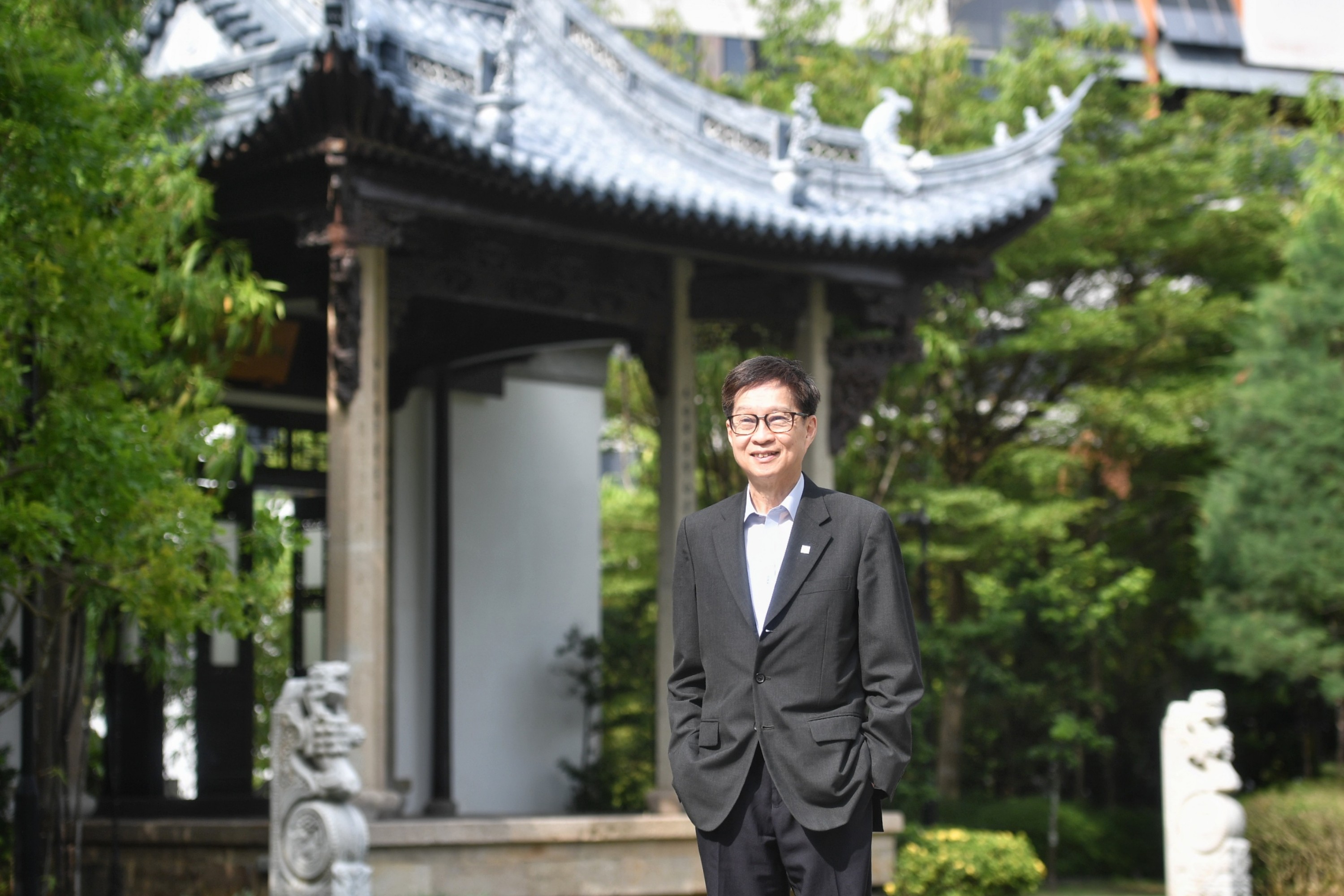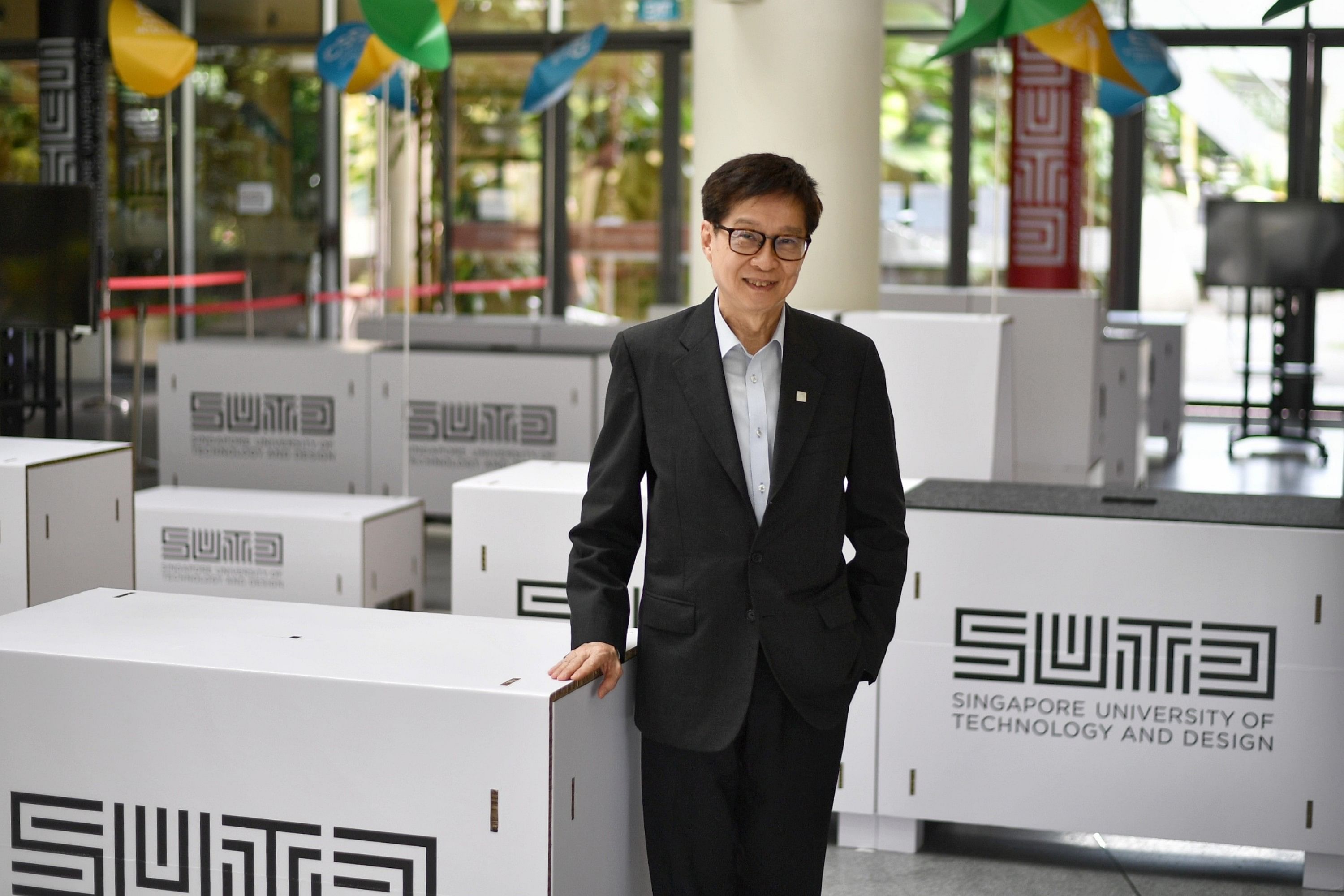Designing a greener and happier world
Sign up now: Get tips on how to help your child succeed

In an interview with ST, Professor Chong explains why design must play a key role in efforts to go green.
ST PHOTO: ARIFFIN JAMAR
Follow topic:
SINGAPORE - It could be as simple as laying out stone slabs on the ground to direct people across a garden, or a staircase painted like piano keys to encourage exercise.
The Japanese term for this is shikake, meaning "device", but is properly understood as using design to influence human behaviour through nudging rather than commanding.
Borrowing the term, Singapore University of Technology and Design (SUTD) president Chong Tow Chong told The Straits Times: "It is a little thing that triggers certain behavioural changes."
Shikake is central to the university's plans to create sustainable human-centred practices, he added. In other words, products or systems have to be designed intelligently so that people will be prompted almost naturally to adopt certain habits.
SUTD launched a wide-ranging sustainability plan in December last year, with the aim of combining its strengths in technology and design to come up with real-world solutions and services.
In its first phase, it will provide $10 million over the next three to five years to research and education in sustainability.
In an interview with ST, Professor Chong explains why design must play a key role in efforts to go green.
Q. What is design as defined by SUTD and how is it related to sustainability?
A: Our degree programmes are totally different from the traditional ones. For example, we have three engineering degrees that are not electrical or mechanical (engineering degrees) - engineering product development; engineering systems and design; and information systems technology and design.
Then we have another degree, called architecture and sustainable design.
Design always means different things to different people. But we cannot talk about design in a vacuum, we must have something to focus on. Our overarching focus is sustainability, which is a broad topic. Every industry sector talks about sustainability.
In 2018, about four years ago, we started looking at what the definition of design for SUTD should be. We eventually said that design, powered by technology, is the informed, intentional, intelligent and imaginative force that will drive innovations to improve lives, grow economies and sustain our world.
Design must be applied in the real world, whether it is designing things with a circular end in mind, ensuring that no component in a product goes to waste, or designing zero-carbon districts in cities, for example.
Q. You mentioned that it is not just about building a sustainable world, but a happier one. What does that mean?
A: Our definition of design is a more human-centric one. Our tagline - a better world by design - can be expanded to say that it is about a more sustainable and happier world. Being sustainable is not about making life difficult for people; we want to make sure that we take into account how humans respond.
We want people to embrace sustainability and not feel that it is an unnecessary chore. Sometimes we do something because we are compelled by law, but we may not be happy. We hope that when we come up with sustainable solutions, people treat them as part of their normal lives.
We need to understand behavioural change; it is not just about infrastructure or renewable energy. Sustainability is not sustainable without behavioural change. Just think about recycling - we need people to be able to collect items properly, but I am not sure how many people actually know how to clean the items before they put them inside the bin.

Professor Chong Tow Chong has been the president of the Singapore University of Technology and Design since April 2018.
The other thing is, whether we are willing to have higher room temperatures or make certain sacrifices. We need to study people's behaviour so we can devise policies that nudge desired behaviour.
Therefore at SUTD, 22 per cent of our curriculum is in the humanities, arts and social sciences. This is important because it is about understanding humans.
Q. SUTD is the Singapore University of Technology and Design. How do these two concepts - technology and design - go hand in hand?
A: To understand how design and technology impact each other, we have to go back in time.
We start from the 1400s, during the Renaissance - design at that time was more about art, jewellery and clothes serving high society - not for the many and not affordable.
During the Industrial Revolution, design changed. Then in the early 20th century, a movement led by a design school in Germany called Bauhaus said that design is not just about form, it is about function.
Now we are in the 21st century, the digital age. We continue to benefit from technology and production, but the issues that the world faces are quite different. For example, because we do mass production, we consume more and waste more and therefore we destroy parts of the earth.
In the digital age, it is more than just machines. You have data, machine learning, and you can use artificial intelligence (AI). So design has to be more intelligent to solve large-scale issues.
To address this, we introduced a new major, Design and AI, which means using AI as a tool to design, which is different from just using your creative thinking. We want to produce designers who also have knowledge of technology, especially AI.
Q. How is SUTD doing its part to create a greener world?
A: Since we established the university, we have made efforts in sustainability. For example, our building has already achieved the Green Mark (Platinum) status, the campus utilises natural ventilation and passive cooling - and this is a heavy investment for us.
We have also invested in human talent development over the past decade and understanding sustainability through building it into curriculum.
Last year we launched a sustainability plan with three main components: research, education and campus. These aspects are not in isolation; they have to come together and support each other to deliver our tagline for a more sustainable and happier world.
Under our new DesignZ centre, we will do research, innovation, services and education. We do not want to stop at research, we want to translate it into outcomes, such as better services for people.
One example of a project undertaken by SUTD researchers is estimating the carbon footprint of cross-border e-commerce shipping options on Taobao.
It was observed that air freight is faster, more expensive and emits more carbon while sea freight is slower, cheaper and emits less carbon.
A survey was conducted to find out if carbon labelling will have an influence over consumers' shipping preferences. Results revealed that 55 per cent of respondents are willing to compromise on the speed of delivery for greener alternatives, hence carbon labelling can potentially influence the choice of e-commerce shipping options.

As we design products and systems, we have to make sure they resonate with people and people are willing to embrace them, even at a price. For example, you will pay a higher price to fly a safer aircraft, or for better food at a high-class restaurant. But are you willing to pay a higher price if I tell you my aeroplane is more sustainable, is this of value to you?
And it is not just about you. It also has to do with the earth that our children's children will inherit. If we do not do our part now, it will affect the next generation.
We need to collect more data about people's behaviour and take this into consideration so that when we make policies, it will not be painful for them to make changes in their lives.
About Professor Chong Tow Chong

Professor Chong Tow Chong, 68, has been the president of the Singapore University of Technology and Design since April 2018.
Prior to that, he was executive director of the Agency for Science, Technology and Research's Science and Engineering Research Council and Data Storage Institute for 15 years.
A President's Scholar, Prof Chong has spent much of his professional career teaching and doing research in semiconductor materials and devices, processing technologies and optoelectronics.
He has authored and co-authored more than 400 publications in international refereed journals, presented over 35 invited talks and registered 25 patents.
He has also had a 30-year academic career with the National University of Singapore (NUS) as professor of electrical and computer engineering.
For his contributions, he was conferred the Public Administration Medal (Silver) in 2004 and (Gold) last year (2021). He was also awarded the National Day Long Service Medal in 2019, as well as the President's Science and Technology Medal in 2010.
Prof Chong has also received numerous teaching and research awards, such as the American Society of Mechanical Engineers ISPS Division Leadership in Research and Development Award in 2014 and the Teaching Excellence Award from the NUS engineering faculty in 1994.
He obtained his bachelor's degree from the Tokyo Institute of Technology, a master's from NUS and a PhD from the Massachusetts Institute of Technology - all in electrical engineering.
He currently serves on the board of directors for the Central Provident Fund, Civil Aviation Authority of Singapore, Home Team Science and Technology Agency, and several schools such as Eunoia Junior College, Hwa Chong Institution, Raffles Institution and Catholic High School.
Register for the forum
To find out more, you can register to attend the virtual Design Innovation Forum by SUTD in partnership with The Straits Times. Registration is free.
SUTD Design Innovation Forum
When:
March 15, 3pm to 5pm
Speakers:
Ms Grace Fu, Minister for Sustainability and the Environment
Professor Chong Tow Chong, SUTD president
Mr Patrik Schumacher, Principal of Zaha Hadid Architects
Mr Topher White, Founder and CEO of Rainforest Connection
Moderator:
Professor Tai Lee Siang, SUTD's head of the architecture and sustainable design pillar and centre director of DesignZ
To find out more, you can register to attend the forum here or scan the QR code

